Have you ever seen a picture of a cozy, round structure nestled in a scenic spot and wondered what it was? It might just be a yurt! Yurts are fascinating dwellings with a rich history, and they’re gaining popularity today for everything from unique vacation stays (“glamping”) to eco-friendly homes.
But what exactly is a yurt? Based on historical design and modern adaptations, let’s dive into everything you need to know about these intriguing round shelters – from their core definition and components to their history, contemporary uses, costs, and the lifestyle they enable.
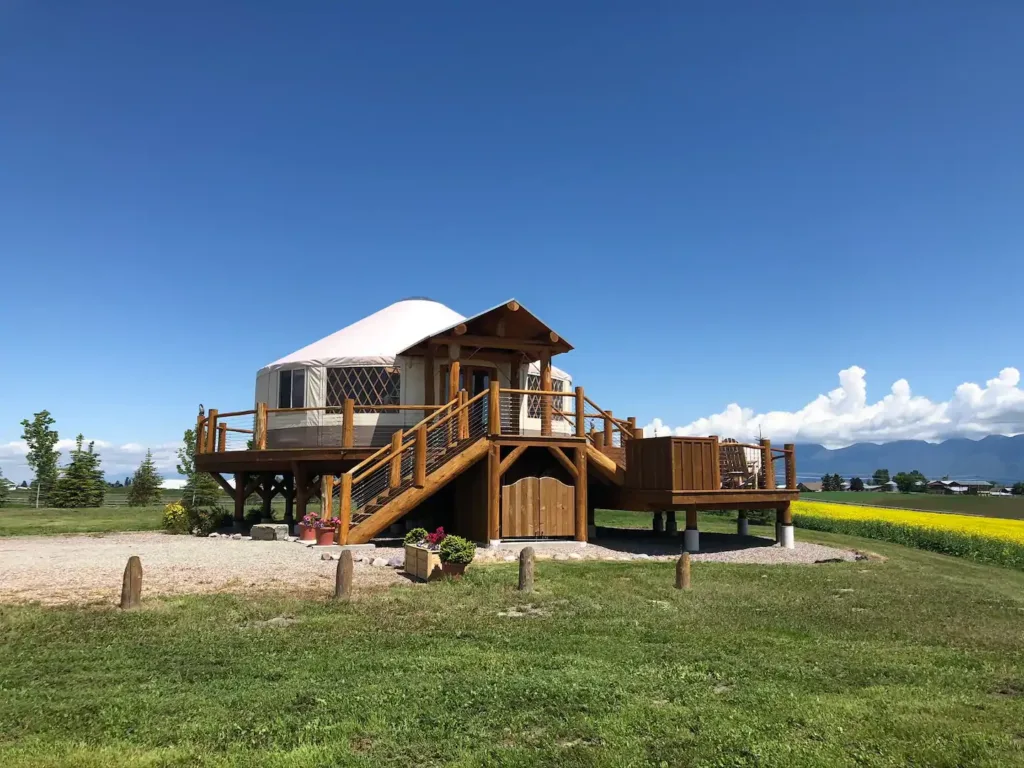
What Is a Yurt? The Basic Definition
At its core, based on centuries of use and evolution, a yurt (sometimes called a “ger,” especially in Mongolia) is a circular dwelling supported by a collapsible frame and typically covered with fabric or felt. It represents a sturdy, efficient, round shelter design with deep historical roots in the nomadic cultures of Central Asia.
Key characteristics consistently define a yurt:
- It’s round, offering structural advantages.
- It uses a lattice wall system, often collapsible.
- It has a conical roof structure meeting at a central ring.
- It relies on tension (via a band or cable) to maintain stability.
The Main Components of a Yurt
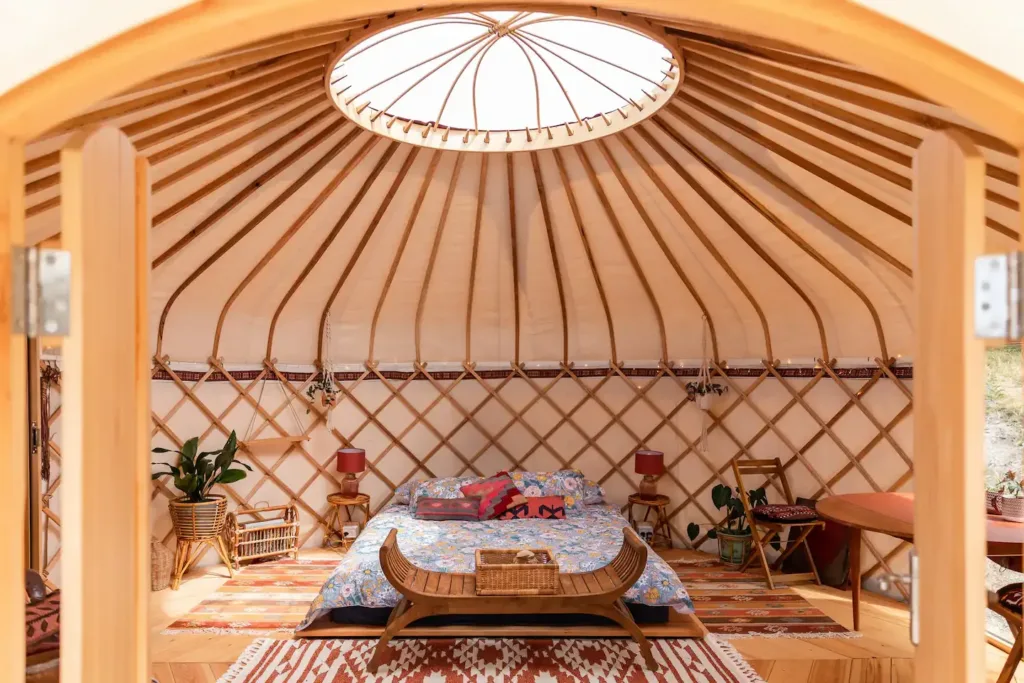
Understanding the parts is key to understanding the whole structure. Engineering principles and tradition dictate these essential components:
- Lattice Wall (Khana): Collapsible wooden sections forming the circular perimeter. Material varies (traditionally willow/birch, modernly often Douglas Fir. Connected with durable ties or hardware.
- Roof Rafters (Uni): Poles radiating from the wall-top to the center ring, forming the roof slope.
- Center Ring (Crown/Toono): The critical compression ring at the roof’s apex, holding rafters. Often includes an opening/skylight. Holds cultural significance in traditional designs.
- Door Frame: Provides a stable entrance and structural support. Size may vary between traditional and modern designs.
- Covering: Protective layers enclosing the frame.
- Traditional: Typically multi-layer felt (sheep’s wool) for insulation, plus outer canvas/hide.
- Modern: Durable, waterproof architectural fabrics (vinyl, treated canvas) often specified by weight (e.g., oz/sq yd), potentially with insulation (reflective foil, etc.) and liner.
- Tension Band/Cable: Strong band (traditionally woven; modernly often high-tensile steel aircraft cable resisting roof thrust at the wall top. Essential for stability.
A Brief History of Yurts
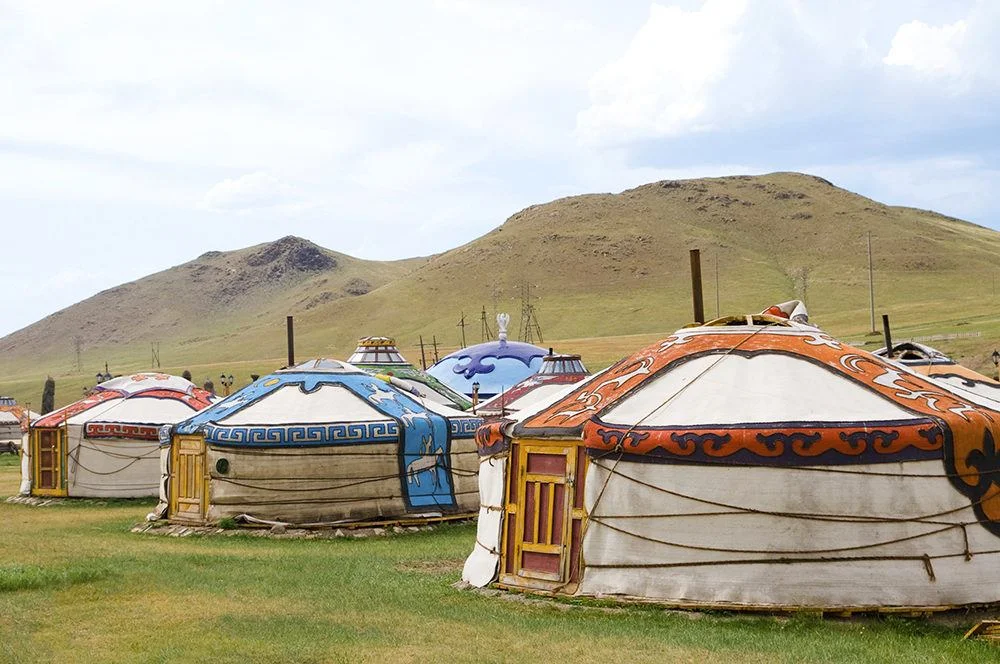
The yurt boasts an ancient lineage, stretching back possibly 3,000 years to Central Asian nomadic peoples.
- Nomadic Necessity: Developed as portable, durable shelters suited to migratory herding lifestyles across harsh terrains. They needed to be easily transportable yet resilient to extreme weather. Construction relied on available resources like wood and animal products (wool, hides).
- Cultural Significance: The yurt (ger) served as the heart of family and community, with specific layouts often reflecting cosmology and social structures.
- Historical Documentation: Early descriptions appear in writings from Herodotus (Scythians, ~440 BC) and later by travelers like Marco Polo observing the Mongol Empire.
- Western Introduction: Gained traction in North America from the 1960s, largely due to William Coperthwaite‘s work adapting the design using modern materials and promoting its potential for sustainable living.
Traditional vs. Modern Yurts: Key Differences
While based on the same principles, modern yurts have evolved:
Foundation: Almost always require a constructed platform (wood, concrete, etc.), whereas traditional gers could often sit directly on the ground.
Materials: Incorporate engineered lumber, steel cables, advanced architectural fabrics, acrylic domes, modern insulation, and standard hardware, contrasting with traditional reliance on local, natural materials.
Permanence: Most modern yurts are designed as semi-permanent structures on platforms, unlike traditional gers built for frequent relocation.
Features: Commonly include standard doors/windows (sometimes glass), opening skylights, integrated stove flashing, and options for plumbing/electrical systems.
Why Are Yurts Popular Today?
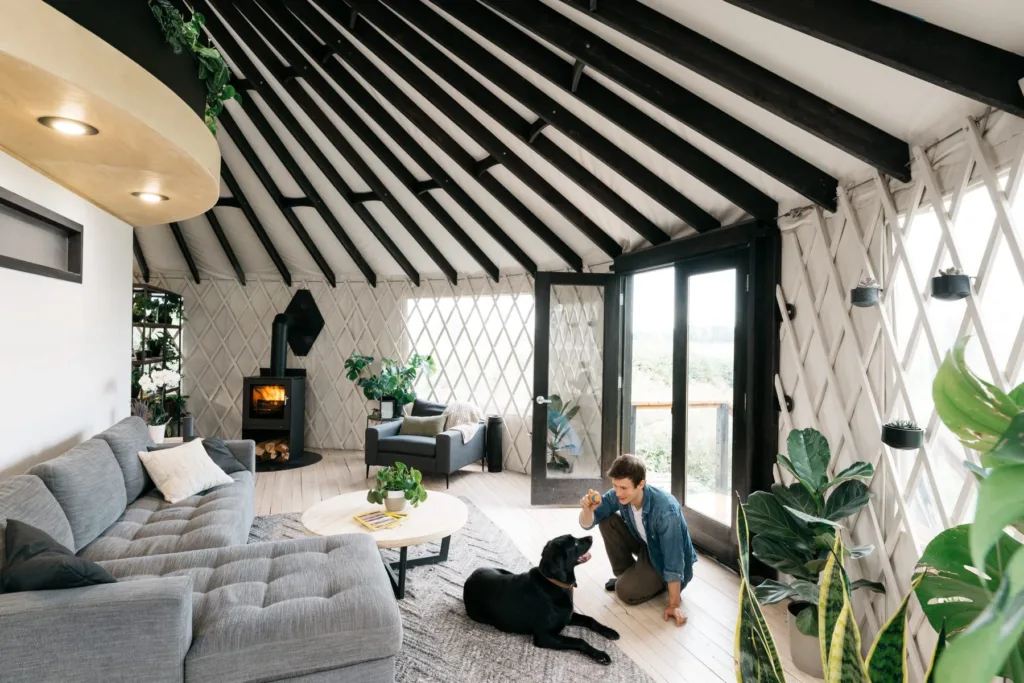
Their modern appeal stems from several factors:
- Unique Experience: Offer a distinct connection to nature, popular for “glamping” and unique accommodations.
- Potential Affordability: Can present a lower initial cost pathway to ownership compared to conventional construction.
- Sustainability Appeal: Align with eco-conscious values due to efficient design, smaller footprint potential, and off-grid compatibility.
- Versatility: Adaptable for diverse uses – homes, rentals, studios, offices, community spaces.
- Aesthetics: Many people are drawn to the cozy, calming feeling of the round space and the beauty of the exposed framework.
Living in a Yurt: Pros and Cons
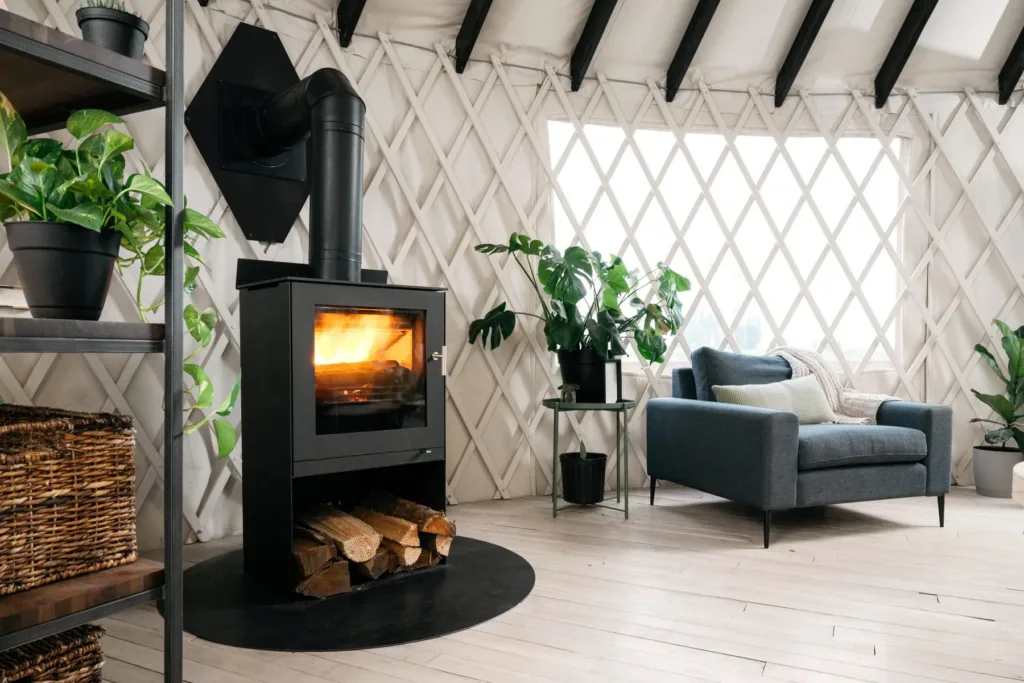
Thinking about spending significant time in a yurt? It’s important to weigh the advantages and disadvantages.
Pros:
- Lower Initial Cost Potential: Kit prices are often less than similarly sized conventional structures.
- Closer to Nature: Design often enhances the feeling of being immersed in the surrounding environment.
- Simpler Living: Finite space can encourage minimalism.
- Eco-Friendly Aspects: Potential for smaller footprint, efficiency, off-grid systems.
- Unique Atmosphere: The round space offers a distinct living experience.
Cons:
- Regulatory Hurdles: Navigating local zoning and permits is often the biggest challenge and varies significantly. Thorough research is crucial before purchase. Talk directly to your local planning/building department.
- Climate Control Demands: Requires careful planning and investment in appropriate insulation (walls, roof, and platform), ventilation (managing humidity is key), and an adequate heating/cooling system for your specific climate.
- Maintenance Needs: Fabric covers require regular cleaning and have a finite lifespan (typically 8-15+ years, depending on quality/climate requiring eventual replacement. Structure may need periodic checks.
- Privacy & Acoustics: Open-plan design and fabric walls offer less sound insulation and visual privacy than standard homes.
- Financing & Insurance: May require seeking out specialized lenders or insurers.
Tip: Experiencing a yurt firsthand (e.g., renting one) and connecting with current yurt dwellers in your climate zone provides invaluable insight.
How Much Does a Yurt Cost in 2025?
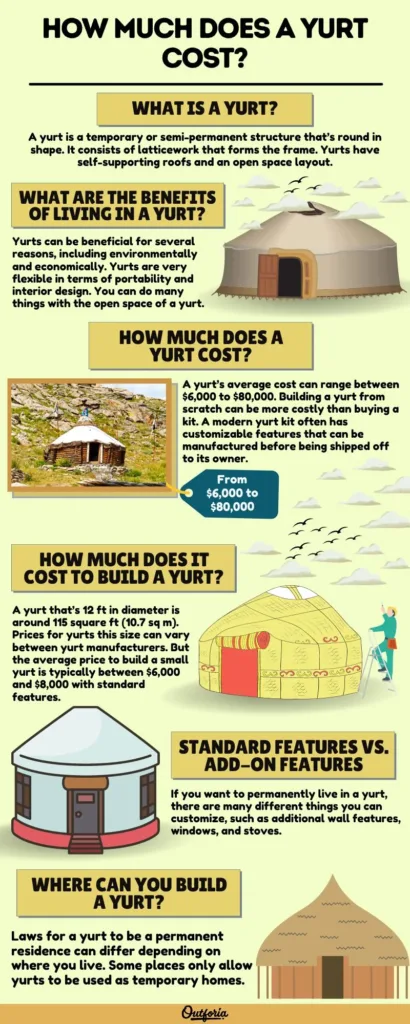
Costs vary widely. This breakdown provides estimates; always get detailed quotes from manufacturers.
Key Cost Factors:
- Size (Diameter): Directly impacts material quantity and cost.
- Materials Quality: Frame wood grade, fabric weight/type (e.g., vinyl vs. treated canvas), insulation R-value or type.
- Features & Options: Number/type of windows/doors, dome type, structural upgrades (snow/wind kits), stove flashing, etc.
- Manufacturer: Brand reputation, quality standards, included features, warranty length/coverage. Consult manufacturer documentation directly.
- Platform: A major separate cost. Varies greatly based on size, materials (wood frame, concrete, SIPs), and labor ($3,000 – $20,000+ is common).
- Shipping: Can add significantly depending on distance.
- Installation: Professional installation vs. DIY labor.
Estimated Base Kit Prices (2025, USD):
- Small (12-16 ft): $6,000 – $12,000+
- Medium (20-24 ft): $9,000 – $20,000+
- Large (27-30 ft+): $12,000 – $30,000+
Important: The total finished cost is often 2-3x (or more) the base kit price, realistically landing between $25,000 – $75,000+ when including the platform, insulation, setup, heating, finishing, and utilities.
Tips for Buying a Yurt
Selecting the right yurt involves careful consideration:
- Define Purpose: Clarify primary use (home, rental, etc.) to guide decisions.
- Choose Size: Assess space needs for occupants and activities.
- Analyze Climate: Select appropriate insulation and structural upgrades (snow/wind) for your specific location’s weather patterns.
- Research Makers: Compare detailed specifications, materials, warranties, reviews, and support.
- Verify Local Regulations: Critical Step! Confirm zoning and permit requirements with your local authorities before buying.
- Create Comprehensive Budget: Include all costs, not just the kit price.
- Prioritize Quality: Durability often provides better long-term value.
Reputable Yurt Manufacturers
Consider these established companies when researching (primarily North America/Europe based). Note: Perform independent research. Inclusion isn’t an endorsement.
- Pacific Yurts: Respected pioneer, quality focus. (
https://www.yurts.com/) - Colorado Yurt Company: Handcrafted, robust engineering. (
https://www.coloradoyurt.com/) - Rainier Outdoor: Premium materials, refined aesthetic. (
https://rainieroutdoor.com/) - Shelter Designs Yurts: Focus on 4-season living. (
https://www.shelterdesigns.net/) - Smiling Woods Yurts: Specializes in wooden yurts. (
https://smilingwoodsyurts.com/) - Freedom Yurt Cabins: Panelized yurt cabins. (
https://freedomyurtcabins.com/) - Groovy Yurts: Imports traditional Mongolian gers. (
https://www.groovyyurts.com/) - Woodland Yurts (UK): UK-based handcrafted yurts. (
https://woodlandyurts.co.uk/)
Are Yurts Eco-Friendly?

Yurts often align with sustainable building principles:
- Material Efficiency: Round shape optimizes enclosed space per unit of wall material.
- Resource Potential: Can utilize renewable resources (wood, wool). Look for manufacturers using sustainably harvested lumber.
- Lower Embodied Energy: Potential for fewer highly processed materials compared to standard construction.
- Reduced Site Impact: Platform foundations typically require less ground disturbance.
- Off-Grid Synergy: Integrates well with renewable energy (solar), efficient heating (wood stoves), and alternative sanitation (composting toilets).
- Energy Efficiency: Achievable with proper insulation (especially platform), air sealing, and ventilation design.
Conclusion: More Than Just a Round Tent
In essence, what is a yurt? It’s more than just a round tent; it’s an ingenious dwelling blending ancient nomadic heritage with modern versatility. Understanding its unique structure, rich history, and the practicalities of yurt living reveals its potential for everything from unique travel experiences to sustainable, minimalist housing. Choosing a yurt means embracing a structure and often a lifestyle that connects occupants closer to nature and the essentials.
FAQs
Can you live comfortably in a yurt year-round?
Yes, but comfort hinges on climate-specific preparation: quality insulation (walls, roof, and platform), adequate heating/cooling, proper ventilation (for moisture), and potential structural upgrades for local conditions (snow/wind).
What’s the realistic total cost to set up a yurt for living?
While base kits range ($6k-$30k+), the total project cost is often $25,000 – $75,000+ USD (2025 est.) including the essential platform, insulation, shipping, setup, heating, utilities, and interior finishing.
What are the biggest pros and cons of yurt living?
Pros: Potential lower initial cost, strong nature connection, encourages simplicity, unique space, sustainability options.
Cons: Difficult local regulations/permits, climate control requires planning/expense, ongoing cover maintenance/replacement, less privacy/soundproofing.
READ NEXT: The 21 Best Yurt Rentals In the USA: Top-rated with Beautiful Location



